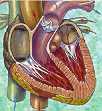What Is The Function Of The Circulatory System
By: Dr. Rita Louise
 The Circulatory System is designed to deliver oxygen and nutrients to all parts of the body and pick up waste materials and toxins for elimination. This system is made up of the heart, the veins, the arteries, and the capillaries.
The Circulatory System is designed to deliver oxygen and nutrients to all parts of the body and pick up waste materials and toxins for elimination. This system is made up of the heart, the veins, the arteries, and the capillaries.
Circulation is achieved by a continuous one-way movement of blood throughout the body. The network of blood vessels that flow through the body is so extensive that blood flows within close proximity to almost every cell.
Heart
The heart is a muscular pump that propels blood throughout the body. The heart is located between the lungs, slightly to the left of center in the chest. The heart is broken down into four chambers including:
- The right atrium, which is a chamber which receives oxygen- poor blood from the veins.
- The right ventricle which pumps the oxygen-poor blood from the right atrium to the lungs.
- The left atrium which receives the now oxygen-rich blood that is returning from the lungs.
- The left ventricle, which pumps the oxygenated blood through the arteries to the rest of the body.
This process occurs about 72 times per minute, every day of our lives.
Blood Vessels
Blood vessels are broken down into three groups: the arteries which carry blood out of the heart to the capillaries, the veins which transport oxygen-poor blood back to the heart, and the capillaries which transfer oxygen and other nutrients into the cells and removes carbon dioxide and other metabolic waste from these body tissues.
Blood Pressure
Blood pressure is the force exerted by the blood against the walls of the blood vessels. The output or direct pumping of the heart and the resistance to blood flow in the vessels determines blood pressure. Resistance is determined by blood viscosity and by friction between the blood and the wall of the blood vessel.
Blood pressure = blood flow x resistance.
© Copyright Rita Louise, Inc. – www.medical-intuitives.com. All rights reserved. This information is provided for educational purposes only. The descriptions of nutritional supplements are based on the historical usage of the various ingredients. They are not intended to promote any direct or implied health claims, and actual results of usage can vary. The statements on this Web site have not been evaluated by the U.S. Food and Drug Administration, and are not intended to diagnose, treat, cure, or prevent any disease.